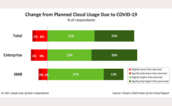Growth Strategy to Accelerate Cloud Computing post-COVID-19

Source:-https://www.ciol.com/
2020 has turned out to be a golden year for cloud computing. Covid-19 has made tech infrastructure companies find innovative ways to meet the accelerated demand for cloud-based offerings. Several existing factors have driven cloud transitions, and now they seem to have accelerated because of the Covid-19 crisis. Cloud spending has increased to 37% in the past year.
This trend is here to stay as the world is more towards virtual work. Despite lockdowns in various parts of the world, a Gartner Report estimated a rise of 19% in 2021 for cloud spending. In 2020, the Cloud Computing industry was valued at $371.4 Billion and is now estimated to reach a whopping $832.1 Billion by 2025 at a CAGR of 17.5%.
How is Cloud Computing helping businesses stay connected?
Due to the Covid-19 pandemic, digital business transformations have entered a challenging phase. The sudden shutdown of offices, schools, SMEs have increased the demand for cloud services. With the lockdowns, there has been a steep increase in the use of video conferencing tools and virtual meeting software. This has led to a massive spike in demand for internet bandwidth. In such cases, cloud computing has been a saviour. It is easy to handle the unexpected spikes in bandwidth usage in a cloud computing scenario.
In many industries such as healthcare and finance, data is the primary asset. Managing and storage of data can be expensive when on-premise servers are chosen. In such scenarios, cloud computing is the best option. It provides access to online data backup and the scalability is high. But one must thoroughly assess the security risks involved and tackle them efficiently to avoid data loss or data leak.
Business collaboration earlier involved face-to-face interaction. These interactions proved critical in ensuring business objectives and large teams helped with these interactions. With the Covid-19 pandemic forcing millions of workers to work remotely, organizations are struggling to create the same office environment and engagement between team members. Cloud helps increase efficiency and also enhances productivity. It allows individuals to share or edit projects in real-time working from different locations and allows the teams to stay connected. Further, it is easier to provide the latest information, updates, developments of the project when organizations are working in a cloud environment. It also allows control over who has access to information ensuring information security.
Global Shift Toward Cloud Computing
In addition to the pandemic, the shift to the cloud has been a long-awaited one. Flexible consumption models like “Everything or Anything as a Service” (XaaS) have become increasingly popular. Cloud computing has enabled strategic shifts for many organizations across industries. With five times more growth forecast for cloud computing models by 2025, organizations opting for these cloud-driven shifts can definitely see more aggregation at lower costs, greater financial predictability and enhanced customer and team collaborations.
Cloud Migration Strategy
Cloud adoption has been moving at a rapid speed. Thus, organizations need to keep up with the pace and ensure the application of information security. Enterprises must understand that cloud migration is not just about moving to the cloud. It is continuous reinvention to check for ways to achieve cost efficiency as well as create new opportunities. It is critical to follow a well-planned approach and adopt cloud migration in a phased manner so that business stays uninterrupted.
As enterprises move towards cloud migration, cost duplication must be kept in check since organizations pay for both cloud and legacy systems as well as cloud synchronization costs must be added too. Many key players provide cost-effective cloud environments which help organizations achieve cost efficiency.
The cloud is now more than just an efficient storage option. Cloud as a platform generates data and provides innovative solutions to leverage that data. More businesses are opting for the cloud to drive innovation, become more agile and save money. Enabling cloud computing has become a necessity for the smooth functioning of the organization than a luxury. It’s no more the question of choice.
Cloud computing is now very much at the centre of any organization’s strategy. That trend, is here to stay despite the steepest economic contraction.